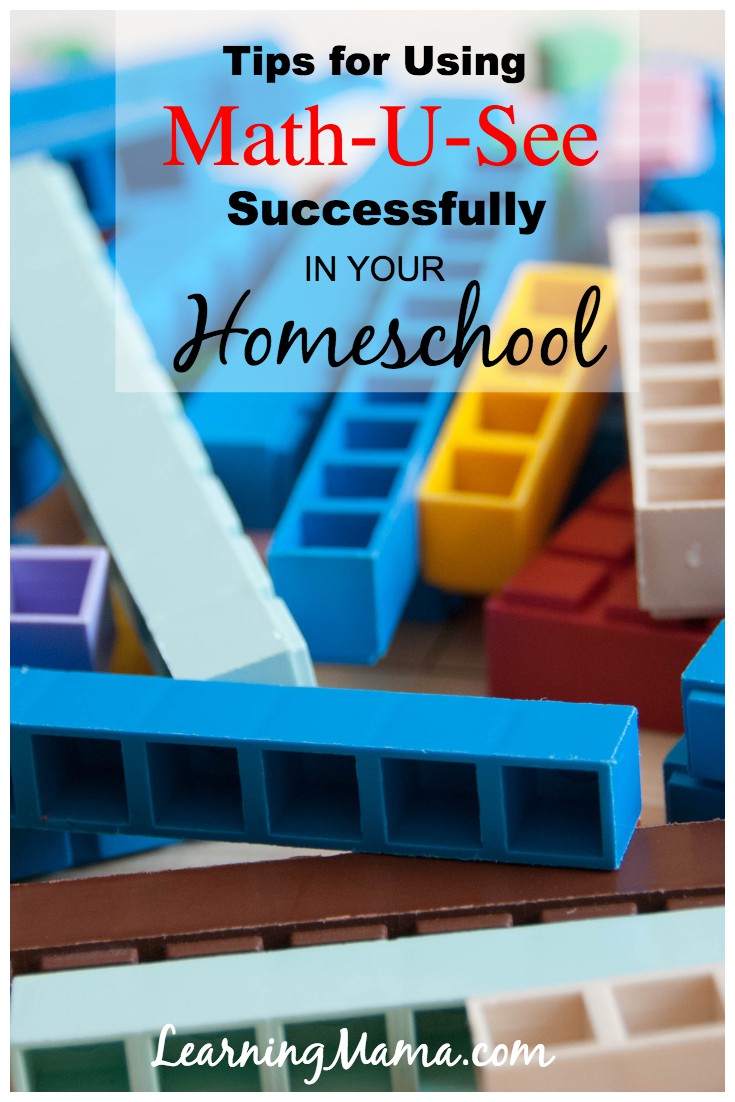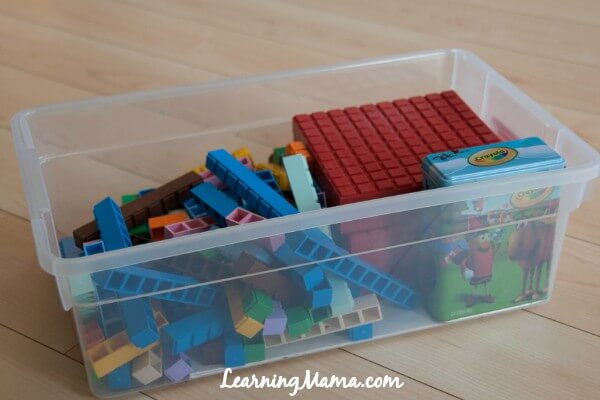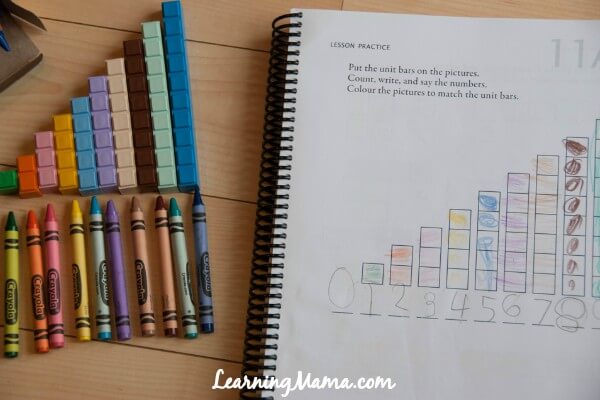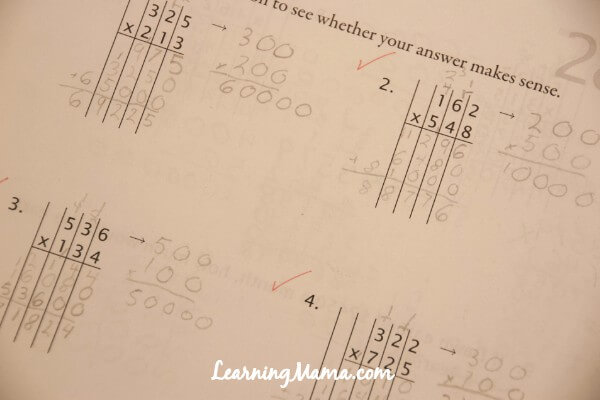It’s pretty rare to find a homeschool mom who waxes poetic on how much she loves teaching math. If you’re like me, maybe you’ve felt anxious about teaching a subject that you hated as a child, or are afraid you just aren’t competent to do it.
Over the years I’ve noticed that most homeschool families I know have tried multiple math curriculums and programs over the years before finding one that sticks — if they ever do. They’ve tried Saxon, Right Start, Horizons, you name it!
I can still remember why I first wanted to use out Math-U-See for our math curriculum. Among the listed math curricula in The Well-Trained Mind’s recommendations was that Math-u-See was suited to parents who are “intimidated by the idea of teaching math, and to children who are very hands-on or visual”.
Intimidated by math? Check. Hands-on & Visual Kids? Aren’t they all?

We started with Math-U-See from the very beginning, and I haven’t regretted it once. That doesn’t mean that math has always been a bed of roses though. We’ve had some hiccups and tears along the way.
Today I’m sharing with you some helpful hints for how you can use Math-U-See successfully in your homeschool. I’m hoping they will save you some frustration, tears, and money as you stick with the curriculum and have it work for your family.
Some of these tips & hints will even ring true no matter which homeschool math curriculum you use.
11 Tips for Using Math-U-See Successfully in Your Homeschool
1. Store your blocks in a large, clear, plastic container
I know Math-U-See has a beautiful wooden box you can buy to organize your blocks. And I know plenty of homeschoolers also have found more economical do-it-yourself alternatives (craft boxes with compartments, tackle boxes), but think about it for a minute — do you really want to be separating and organizing math blocks after every math lesson?
I don’t! I’ve found that using a clear, plastic Rubbermaid bin that is large enough for little hands to rummage around in without causing all the blocks to spill over the sides is ideal. It makes for easy clean-up that even your youngest Math-U-See-ers can take care of independently.

2. Match crayons to block colours & store them with blocks
While we’re on the subject of bins & blocks, why not take a few extra minutes while you’re setting yours up for the first time to add a little container with the crayons that are the perfect match for the blocks? Those early levels of Math-U-See have your kiddos doing a lot of colouring and matching to blocks and your lessons will be delayed regularly if you have to find them anew each time. Find the correct colours, designate them for math use only, and throw them into the bin!

3. Make sure your student gets place value down cold
In my opinion, Math-U-See’s teaching of place value leaves all others in the dust. And that’s great, because EVERY level of Math-u-See, of any math program really, hinges on the mastery of this concept. Repeat after me er.. Mr Demme: “To compare or combine, they must be the same kind” “Every value has a place”!
4. Don’t do every page
This is something I didn’t fully embrace until recently, but you don’t need to do every page! Because Math-U-See is a mastery-based curriculum, you can feel free to skip lesson pages and move on once your child has mastered a concept. Breeze through what your child finds too easy, and save your time for what they find more challenging.
5. Use the worksheet generator for extra practice
So what do you do if your child has worked through all six lesson pages and STILL isn’t getting it? Math-U-See’s website offers a handy worksheet generator just for this purpose. The worksheet generator lets you select the lesson number or numbers that you would like practice sheets for, and even gives you options for the number of questions and page layout. Best of all, it generates an answer sheet too!
6. Add math drills and supplements as necessary
Math-U-See is a complete curriculum — it has no holes! But it’s unrealistic to think that your child will be able to memorize their math facts just by completing math worksheets. Often, math facts take a lot of practice before they stick. Math games, flash cards, or online drills are a great way to cement those facts. XtraMath has been hugely successful for us!
Even though Math-U-See is a complete curriculum, you may still need (or want) to supplement. Some children may need different strategies in order to master a concept. If your child is really struggling after you have taught and re-taught, it may be necessary to get extra help. A tutor, some YouTube videos, or even a homeschool math supplement may make the world of difference.
7. Try not to have multiple students starting new lessons on the same day
If you are working for mastery and moving forward at your individual child’s pace it may be difficult — but as much as possible try not to have your children starting new lessons on the same day. If your children begin each lesson with the DVD instruction with Mr Demme, there will be a line up for the DVD player. Having multiple children starting new lessons on the same day can also stretch you as the teacher pretty thin! It’s so much better if you can focus your teaching attention on just one student per day.
8. Use graph paper (or lined paper turned sideways)
It can be really hard to keep everything lined up — do your kids a favour and show them the trick of turning a piece of lined paper sideways. Or, better yet, get a stack of graph paper (make sure the squares aren’t super tiny) to help them keep the columns AND rows all lined up while they work.
9. Don’t be afraid to camp out for a while at the end of Gamma
I can remember the frustration I (and my daughter!) felt as we neared the end of the Gamma workbook. Multidigit multiplication is tough stuff for an 8-year-old, even with Tips # 5 & 8. I thought we were going to be stuck there forever!
I suspected the problem was related to maturity — she understood the concepts, the mechanics, and single digit multiplication was a breeze. It just seemed that the more numbers that were added to the problem, the potential for error there was. Columns not lining up. Steps being skipped. Even providing her with a times table that she could copy from didn’t remedy the problem.
So we kept working at the level where she was comfortable, and I introduced the much easier concepts of division from the beginning of the Delta book. After about 4-6 months, she was able to tackle the end of that dreaded Gamma book and then easily finish off the long division in Delta.

I love that Math-U-See isn’t a graded curriculum. You don’t have to complete a book each year, and your child doesn’t have to be discouraged if their math book doesn’t match their grade level. Don’t be afraid to camp out for as long as it takes, whether it’s multiplication, fractions, or exponents that is tripping your student up.
Also, I just started another student on Gamma this year — send chocolate!
10. Correct math daily & work for mastery
I hate marking as much as anyone, but it’s so important! What can happen if you leave all your marking to the weekend? Well, your child can waste an entire week making the same mistake over and over again
I’ve found what has worked best in our homeschool (although not very convenient!) is to mark math exercises as quickly as possible after the child has completed them — and then hand them back to be corrected until perfect. The near immediate feedback seems also to have a motivating effect and your student is more likely to work carefully and get it right the first time if they know they have to work until it’s all correct.
11. Resist the temptation to have students mark their own work
I’ve seen a lot of information promoting self-correction of work. I’m sure it can be a good thing for mature learners — but I want to offer two HUGE cautions if you want to go that route.
Firstly, correcting your child’s work keeps you in the loop. When you see what your student is struggling with, you are able to help them and ensure that they are learning and not just moving forward. What good does it do to fill a page with x’s and √’s and then move on the next day without re-working the problem, identifying problems, and getting it right?
Another, perhaps even greater reason not to have your child self-correct their math work is the huge potential for cheating. I know none of us wants to believe that our little darlings would lie or cheat, but the truth is, I have heard of more than one homeschool student who has fallen into this trap. The lure of the answer book is just too great, and parents are flabbergasted when they make this discovery.






We use this, and we love it! Regarding additional practice resources, we’re using Bedtime Math. We started with one of the books and now do 1 or 2 problems every day using the app. I’m an English professor, so that naturally means I’m math-challenged 🙂 Your blog and resources have been a life saver for my uncertain journey into math instruction!
We’ve loved Bedtime Math too — and along the same vein, if you can get your hands on an old copy of Mathmagic it’s excellent!
Thank you for the recommendation–and apologies for my delayed reply.